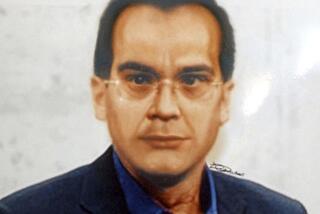Mengele in Portugal in ‘80, Senator Says
- Share via
WASHINGTON — Sen. Alfonse M. D’Amato (R-N.Y.) said Sunday that Dr. Josef Mengele, the fugitive “Angel of Death” of the Auschwitz concentration camp, left his sanctuary in Paraguay in the 1960s “when the heat was most pronounced” and was living in Portugal as recently as 1980.
D’Amato, who has joined in a lawsuit with the Simon Wiesenthal Center for Holocaust Studies in Los Angeles to force the federal government to declassify documents about Mengele, also asserted that the notorious Nazi war criminal has the ability to move in and out of Portugal and Latin America “rather easily.”
“Friends of his in Paraguay were receiving communications--Christmas cards, etc.--as recently as 1980,” the senator said. “They were stamp-marked and postmarked from a European country--from Portugal. Mengele traveled (and) had great access . . . in Paraguay, Brazil and Argentina.”
D’Amato, who was interviewed on ABC-TV’s “This Week with David Brinkley,” cited no source for his statement that Mengele, who would be 73 if still alive, was in touch with friends five years ago. He said he will be releasing more information on Mengele this week. But he added that he does not know where Mengele--who heads the list of Nazi war criminals still at large--may be hiding today.
The Justice Department, at the direction of Atty. Gen. William French Smith, recently began an investigation into the whereabouts of Mengele, who performed hideous medical experiments on thousands of Auschwitz prisoners and is accused of having sent at least 400,000 people, mostly Jews, to their deaths at the camp.
The department’s investigation also seeks to determine whether U.S. authorities had any contact with Mengele after World War II. Evidence has surfaced that Mengele might have been arrested by American officials in Vienna in 1947 and later freed.
Rabbi Marvin Hier, dean of the Wiesenthal Center, said in a separate interview on the ABC News program that documents he has obtained or expects to obtain from the U.S. Army under the Freedom of Information Act do not confirm or deny that Mengele was once held in U.S. custody.
He added: “For sure, the U.S. Army at Ft. Meade does not know what it has in its files on the question of Josef Mengele. We have absolute proof of that. The only way we’ll ever know what the U.S. Army has . . . is if an investigating team goes in and sifts through, document by document, because the computer definitely is not reliable.”
D’Amato said, however, that he is “quite convinced” that Mengele came into U.S. custody. The senator said that he bases his judgment on the statements of Walter Kempthorne, a 59-year-old retired engineer from Riverside, Calif., who was an Army private during World War II.
Kempthorne told reporters Thursday at a news conference at the Wiesenthal Center that he saw a man identified as Mengele while assigned to guard duty at a prison for war criminals in Germany.
Allan A. Ryan, Jr., former director of the Justice Department’s Office of Special Investigations, another guest on the ABC program, cautioned that information on Mengele’s whereabouts is sketchy.
But he said that it is almost certain that, even if Mengele was once in U.S. custody, he did not work for the Americans after the war as a counterintelligence agent or in any other capacity.
“Josef Mengele spent the war years as a torturer in a death camp,” Ryan said. “Even putting aside the moral question, I haven’t any idea what skills or information he would have had that would have been of use to the U.S. government.”
More to Read
Sign up for Essential California
The most important California stories and recommendations in your inbox every morning.
You may occasionally receive promotional content from the Los Angeles Times.












